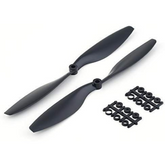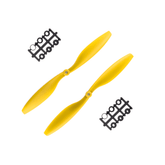All About Drone Propellers
Summary
Unlock the skies with our comprehensive guide, 'All About Drone Propellers.' Dive into the world of unmanned flight as we explore key facets such as Propeller Sizes, Materials, Pitch, and Diameter. Discover the science behind propeller dynamics and the impact on drone performance. Learn essential maintenance tips to keep your drone soaring. Whether you're a novice or seasoned enthusiast, this blog caters to all. Soar through the details and elevate your drone experience! Don't miss the flight – read on and propel your knowledge to new heights!
Introduction
Drones have exploded in popularity in recent years for both personal and commercial use. Also known as unmanned aerial vehicles (UAVs), drones rely on sets of spinning propellers to generate the lift, thrust, and maneuverability to fly.
The propellers are thus an integral component that impacts flight characteristics and safety. On consumer camera drones, the design and construction of the propellers influence payload capacity, hover accuracy, stability in high winds, and handling.
Drone propellers must be extremely lightweight yet durable enough to withstand impact at high RPM speeds. For racing drones and other fast-moving UAVs, prop responsiveness and efficiency affect acceleration, top velocities, and overall agility.
In this comprehensive guide, we delve into the various aspects of drone propellers and how they impact real-world performance.
We explore standard propeller sizes from micro to large format, materials from fragile plastics to rigid composites, ideal pitch and diameter properties, aftermarket replacements, and maintenance best practices to extend usable life.
Whether you are just starting out in the hobby or are looking to push your professional drone capabilities further, read on to uncover essential knowledge.

Different Drone Propeller Sizes
Drone propellers range dramatically in terms of blade diameter, measured inch-by-inch from tip to tip. Common sizes for hobby drones include:
- Micro: Under 3 inches - Best suited for palm-sized “toy” quadcopters and nano camera drones meant for indoor restricted space flight maneuvers. Very lightweight and safe plastic build. Example: 1.2-inch diameter drone propellers found on the popular TinyWhoop series for learning first-person view (FPV) racing techniques. Sub-inch sized propellers can even be discovered on fast micro brushless whoop racers for maximum agility.
- Small: 3-5 inches - Ideal size to balance maneuverability, efficiency, and stability in a lightweight form factor. Most mini racing quads utilize 3-inch to 5-inch propellers customize built for brisk acceleration and extreme cornering velocity wearing FPV goggles. At just under 5 inches, propeller blades start to generate meaningful thrust for small camera drones like the DJI Mavic Mini.
- Medium: 6-8 inches - Provides substantial lifting capacity for midsize aerial photography drones carrying a compact mirrorless camera and 3-axis gimbal stabilizer, in addition to the onboard flight battery and electronics hardware. Allows for sustained steady hover and smooth video capture in moderate wind conditions. Many consumer drones in the popular DJI Phantom lineup employ 6-inch to 7-inch low-pitch rotors for optimal stability and 16-20 minutes of flight time on a single charge.
- Large: 10+ inches - Reserved for professional filmmaking drones that heft professional interchangeable lens DSLR or cinema cameras in a stabilized gimbal mount. The lifting capacity and torque required demands high-pitch 10+ inch propeller sets, allowing video production teams to acquire sweeping aerial establishing shots. Integrated multi-rotor systems with supporting landing gear also provide payload headroom for other accessories, such as onboard LED lighting panels for scenes captured after dusk. However, the massive props can be cumbersome in cramped locations.

In terms of number of blades per propeller, most common consumer drones utilize 2-blade or 3-blade configurations. 2-blade props generate greater rotational velocity cutting through air which equates to responsive handling.
But the asymmetric aerodynamic imbalance leads to more vibration which is exacerbated with payload weight increases. 3-blade drone props spin slower and provide greater steadiness and balance under load.
However, they are less agile reacting to rapid user steering and throttle inputs. Modern flight controller software incorporating gyroscopic stabilization helps compensate for these handling trade-offs depending on flying style priorities.
Tips for selecting the perfect drone propeller for your drone.
Drone Propeller Materials
The optimal drone propeller material blend balances durability, rigidity, weight and cost variables.
Lower density and greater tensile strength allows props to spin faster with less wind resistance, translating into better response, top speeds, and mile range capabilities.
However, maximizing flight efficiency can require sacrificing resilience. Various common materials include:
- Plastic Polymer Composites - Most hobbyist camera drones and racing quads feature propellers molded from glass or carbon fiber reinforced polycarbonate, nylon, or ABS plastics. High grade polymer composites strike a balance between flexibility and robustness, while keeping mass down. Compared to metal alternatives, plastic props are generally affordable as consumable breakage replacement parts. Various specialty formulations exist. For example, biodegradable polylactic acid (PLA) nano-ceramic infused plastic provides heat resistance at high RPM.
- Carbon Fiber - Offers exemplary strength-to-weight ratios out of all drone prop materials. 100% carbon props have strict tolerances to eliminate balance unevenness and flutter perturbation forces during high velocity spins over 1500 RPM. The stiff properties mean less bend under pressure for superior slicing aerodynamics. However, carbon is still brittle when impacted, and expensive to manufacture requiring autoclaves. Most drones reserve pure carbon construction for replacing racing quad propeller blades; the central hub sleeve remains glass reinforced plastic for cost savings.
- Wood - A niche material favored by hobbyists building custom ornithopters mainly for aesthetics approximating natural bird flight. Balsa wood choices range from sustainably-sourced lightweight hardwoods to proprietary laminated composites like Taquiso offering dimensional stability. However, moisture absorption can be an issue over time. Wood props work adequately on very slow flyer antique replica builds but are uncommon in most modern drones.
- Hybrid Composites - Many proprietary propeller platforms aimed at commercial UAV applications combine carbon fiber and fiberglass in a thin sandwich construction layering methodology for the ideal blend of strength, flexibility and vibration damping qualities. Autoclave manufacturing constraints are avoided by using high pressure compression techniques to cure the resins. Leading aviation brands developing next-gen hybrid composites optimized for drones include Graupner and APC.
Compatibility Note: Motors, prop nut hole diameters, rotational direction, max RPMs and other electrical factors determine which aftermarket drone propellers can be mixed across brands or frame types.
Consult your flight controller guide to identify technical specifications for appropriate substitutes. Never blindly swap props without due diligence.
Drone Propeller Pitch and Diameter
Two defining specifications ultimately determine how much upward push force a spinning prop can generate: pitch and diameter. These two variables must be balanced properly to produce adequate lifting capacity for hovering and forward flight momentum.
- Pitch - The theoretical “bite size” distance traveled through air with each full revolution if projecting a 2D slice horizontally. Specified in inches. Fixed pitch drone props embed this angular twist angle into the mold permanently. Higher pitch angles let the prop blades achieve greater vertical lift for the attached mass at lower RPM velocities. However commercial drones conservatively utilize low pitch angle props for flight stability reasons.
- Diameter - As described earlier, the end-to-end size measured in inches or mm. Again, bigger propeller surface area exposed to airflow means much higher levels of thrust. But response time accelerating and stopping suffers.

Ideally, your aerial photography drone setup should utilize the largest diameter fixed pitch propellers possible for your intended payload weight (i.e camera, gimbal, extra batteries) and weather conditions, while still allowing for reasonable maneuverability.
For example, the stock DJI Phantom 4 pairs 5-inch diameter low pitch props which sufficiently hoists a 4K stabilized camera rig upwards with minimal lag.
Enthusiasts can tweak parameters further - upsizing to aftermarket 6-inch or 8-inch props enables lifting up to 10 pounds of equipment for extended duration and range thanks to added torque and efficiency.
This allows getting more creative attaching accessories like multi-axis gimbal stabilizers or onboard spotlights when permitted.
In practice, doubling the drone propeller diameter theoretically will quadruple the amount of thrust generated, although advancements in electronic speed controller and brushless motor innovations helping power the latest drones provide further leverage to eek out as much performance as science allows from the finite onboard battery source.
Custom built FPV racers stretch the limits using latest generation 4S/6S LiPos discharge capacities to spin high-KV outrunner motors at 30,000+ RPM to achieve blistering straight line speeds above 80 MPH!
Propeller Maintenance
To extend drone propeller lifespan between inevitable mishap replacements, follow these maintenance best practices:
- Inspect blades routinely for signs of damage like chips, cracks and bends which cause balance issues. Catch problems early before causing a dangerous in-flight failure and crash.
- Take care when transporting your drone to avoid bumps and accidental prop fold snapping. Consider removing the props entirely when traveling if storage space in a backpack or drone case allows.
- Take caution when handling sets of drone propellers. Even non-spinning plastic blade edges can be unexpectedly sharp and cause cuts if brushed up against carelessly.
- When installing propellers onto motors, never over tighten nuts which can lead to gear box damage or stripped threads. Hand tight with a gentle nip of force is ideal.
- Ensure prop hub sleeves spin smoothly without friction along the metal motor shaft. Lubricate with a small drop of hobbyist-grade machine oil if squeaking sounds arise.
- Avoid mechanical damage by stopping plastic props completely before attempting removal. Never grab, pry or bend props while motors are still live spinning.
- Limit dust build-up with periodic cleaning using pressurized air canisters. Lightly brush off surface debris clumps with a microfiber cloth. Avoid submerging props in chemical cleaning solutions which can degrade material integrity over time with exposure.
- Let excess moisture fully evaporate if props get wet before flying again. Water drops flung off at thousands of RPM act like destructive ball bearings grinding down leading edges. Prolonged soaking also negatively impacts structural integrity depending on material makeup.
By being gentle with propeller handling and storing them safely in a marked plastic bag when not in use, you can certainly attain dozens of flying sessions before needing replacements. Happy landings!
Conclusion
We explored why propellers are the unsung heroes allowing drones to defy gravity. These rapidly spinning wings generate the required aerodynamic forces to lift your drone’s mass skyward.
And propeller design factors like size, shape, material and pitch angle all influence UAV capabilities ranging from flight endurance to top speed potential. Whether building your own custom racer, or buying an off the shelf photography quadcopter, be sure to select the prop configuration optimized for your mission parameters.
An mismatch means wasting battery and motor torque inefficiencies. With routine inspection and maintenance, propellers should deliver reliable performance for many hours aloft before requiring swap outs.
As aviation technologies continue maturing, next generation drone propeller materials and blade geometries promise even longer operational lifespans for drones of all shapes and sizes.








